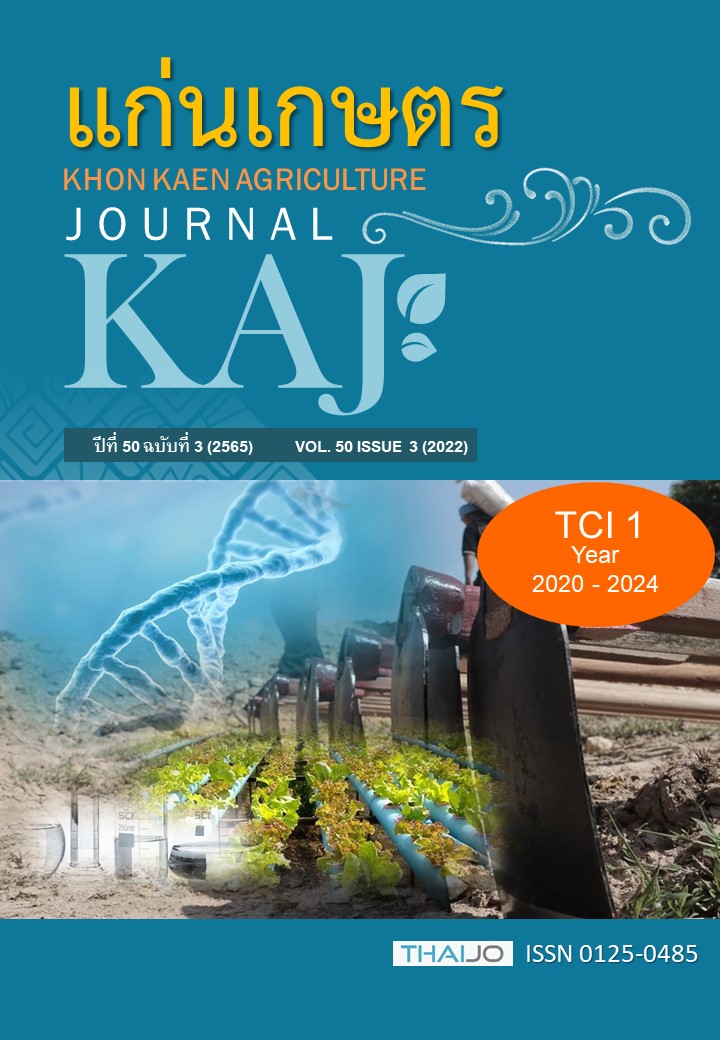อิทธิพลของการกระทบแล้งและวิธีการขยายพันธุ์ต่อลักษณะการเจริญเติบโตของกาแฟโรบัสต้า
Main Article Content
บทคัดย่อ
ความแห้งแล้งเป็นปัญหาที่สำคัญต่อการผลิตกาแฟโรบัสต้า แต่ข้อมูลการตอบสนองต่อความแห้งแล้งของพันธุ์กาแฟโรบัสต้าที่ปลูกในประเทศไทยยังมีจำกัด การศึกษานี้จึงมีวัตถุประสงค์เพื่อศึกษาอิทธิพลของการกระทบแล้งและความแปรปรวนของพันธุ์ต่อการเจริญเติบโตของกาแฟ ประเมินอิทธิพลของวิธีการขยายพันธุ์ต่อความสามารถในการทนแล้งของกาแฟ และหาความสัมพันธ์ระหว่างความทนแล้งกับลักษณะการเจริญเติบโตของกาแฟ โดยทดสอบพันธุ์กาแฟโรบัสต้าที่ขยายพันธุ์ด้วยวิธีต่าง ๆ รวม 6 ประเภท ดังนี้ 1) กาแฟพันธุ์ FRT141 จากการเพาะเมล็ด 2) กาแฟพันธุ์ FRT141 จากกิ่งปักชำ 3) กาแฟพันธุ์ SC05 จากการเสียบยอด 4) กาแฟพันธุ์ SC05 จากกิ่งปักชำ 5) กาแฟพันธุ์ PP01 จากการเสียบยอด และ 6) กาแฟพันธุ์ PP01 จากกิ่งปักชำ เปรียบเทียบระหว่างสภาพปรกติและสภาพความแห้งแล้ง เก็บข้อมูลการเจริญเติบโตและน้ำหนักแห้งของกาแฟ พบว่า การกระทบแล้งส่งผลให้จำนวนใบ พื้นที่ใบ เส้นผ่านศูนย์กลางลำต้น และน้ำหนักแห้งรวมลดลง แต่มีอัตราส่วนรากต่อยอดเพิ่มขึ้น วิธีการขยายพันธุ์ด้วยการเสียบยอดกาแฟบนต้นตอพันธุ์ทนแล้ง สามารถช่วยให้กาแฟมีการเจริญเติบโตดีขึ้นและช่วยเพิ่มความสามารถในการทนแล้ง กาแฟโรบัสต้ามีความสามารถในการทนแล้งแตกต่างกันระหว่างพันธุ์ โดยกาแฟพันธุ์ FRT141 จากการเพาะเมล็ดมีความทนทานต่อความแห้งแล้งสูงที่สุด และพบความสัมพันธ์ระหว่างน้ำหนักแห้งรวมกับความสูงต้น (r=0.83**) ความกว้างทรงพุ่ม (r=0.87**) พื้นที่ใบ (r=-0.72**) และน้ำหนักแห้งราก (r=0.73**) ภายใต้สภาพความแห้งแล้ง แสดงว่าลักษณะเหล่านี้เกี่ยวข้องกับความทนทานต่อความแห้งแล้งของกาแฟโรบัสต้า
Article Details

อนุญาตภายใต้เงื่อนไข Creative Commons Attribution-NonCommercial-NoDerivatives 4.0 International License.
เอกสารอ้างอิง
กรมวิชาการเกษตร. 2562. คู่มือการจัดการ: การผลิตกาแฟโรบัสต้า. สถาบันวิจัยพืชสวน กรมวิชาการเกษตร. แหล่งข้อมูล: https://www.doa.go.th/hc/chumphon/wp-content/uploads/2020/02/robusta-production.pdf. ค้นเมื่อ 9 กุมภาพันธ์ 2564.
กรมส่งเสริมการเกษตร. 2557. การเพิ่มประสิทธิภาพการผลิตกาแฟ. โรงพิมพ์ชุมนุมสหกรณ์การเกษตรแห่งประเทศไทย จำกัด, กรุงเทพฯ.
จิรา ณ หนองคาย. 2551. หลักและเทคนิคการขยายพันธุ์พืชในประเทศไทย. โอ. เอส.พริ้นติ้งเฮ้าส์, กรุงเทพฯ.
สำนักข่าวไทย. 2557. ไร่กาแฟชุมพรแล้งหนักสูญ 100 ล้านบาท หวั่นปีนี้ไม่มีขาย. แหล่งข้อมูล: http://www.mcot.net/site/content?id=532a9913be0470b5038b45f7. ค้นเมื่อ 8 มีนาคม 2560.
สำนักงานเศรษฐกิจการเกษตร. 2560. สถิติการเกษตรของประเทศไทย ปี 2560. กระทรวงเกษตรและสหกรณ์, กรุงเทพฯ.
สำนักงานเศรษฐกิจการเกษตร. 2563. ข้อมูลการผลิตสินค้าเกษตร: ตารางแสดงรายละเอียดกาแฟ. แหล่งข้อมูล: http://www.oae.go.th/assets/portals/1/fileups/prcaidata/files/coffee62.pdf. ค้นเมื่อ 9 กุมภาพันธ์ 2564.
Barrs, H.D. 1968. Determination of water deficits in plant tissues. P. 235-368. In: T.T. Kozowski. Water Deficits and Plant Growth. Academic Press, NY.
Brunner, I., C. Herzog, M.A. Dawes, M. Arend, and C. Sperisen. 2015. How tree roots respond to drought. Frontiers in Plant Science. 6: 1–16.
Chemura, A., C. Mahoya, P. Chidoko, and D. Kutywayo. 2014. Effect of soil moisture deficit stress on biomass accumulation of four coffee (Coffea arabica) varieties in Zimbabwe. ISRN Agronomy. Article ID 767312, 10 pages.
Cheserek, J.J., C.O. Omondi, and J.M. Ithiru. 2015. Screening for drought tolerance among Coffea arabica cultivars in Kenya. International Journal of Research in Agricultural Sciences. 2: 2348 – 3997.
DaMatta, F.M., and J.D.C. Ramalho. 2006. Impacts of drought and temperature stress on coffee physiology and production: A Review. Brazilian Journal of Plant Physiology. 18: 55–81.
DaMatta, F.M., C.P. Ronchi, M. Maestri, and R.S. Barros. 2010. Coffee: environment and crop physiology. P. 181-216. In: F.M. DaMatta. Ecophysiology of Tropical Tree Crops. Nova Science Publishers, NY.
DaMatta, F.M., R.T. Avila, A.A. Cardoso, S.C.V. Martins, and J.C. Ramalho. 2018. Physiological and Agronomic Performance of the Coffee Crop in the Context of Climate Change and Global Warming: A Review. Journal of Agricultural and Food Chemistry. 66: 5264–5274.
Dias, P.C., W.L. Araujo, G.A.B.K. Moraes, R.S. Barros, and F.M. DaMatta. 2007. Morphological and physiological responses of two coffee progenies to soil water availability. Journal of Plant Physiology. 164: 1639–1647.
Júnior, S.A., R.S. Alexandre, E.R. Schmildt, F.L. Partelli, M.A.G Ferrão, and A.L. Mauri. 2020. Comparison between grafting and cutting as vegetative propagation methods for conilon coffee plants. Acta Scientiarum. 35: 461-469.
Kufa, T., and J. Burkhardt. 2013. Studies on root growth of Coffea arabica populations and its implication for sustainable management of natural forests. Journal of Agricultural and Crop Research. 1: 1-9.
Melke, A., and M. Fetene. 2014. Eco-physiological basis of drought stress in coffee (Coffea arabica L.) in Ethiopia. Theoretical and Experimental Plant Physiology. 26: 225-239.
Myer, R., A. Kawabata, A. Cho, and S.T. Nakamoto. 2020. Grafted coffee increases yield and survivability. HortTechnology. 30: 428-432.
Novaes, P., J.P.D. Souza, and C.H.B.A. Prado. 2011. Grafting for improving net photosynthesis of Coffea arabica in field in Southeast of Brazil. Experimental Agriculture. 47: 53-68.
Pham, T.T., B.L. Giang, N.H. Nguyen, P.N.D. Yen, V.D.M. Hoang, B.T.L. Ha, and N.T.T. Le. 2020. Combination of mycorrhizal symbiosis and root grafting effectively controls nematode in replanted coffee soil. Plants. 9: 1-11.
Pinheiro, H.A., F.M. DaMatta, A.R.M. Chaves, M.E. Loureiro, and C. Ducatti. 2005. Drought tolerance is associated with rooting depth and stomatal control of water use in clones of Coffea canephora. Annals of Botany. 96: 101–108.
Roonprapant, P., A. Arunyanark, and C. Chutteang. 2021. Morphological and physiological responses to water deficit stress conditions of robusta coffee (Coffea canephora) genotypes in Thailand. Agriculture and Natural Resources. 55: 473–484.
Silva, P.E.M., P.C. Cavatte, L.E. Morais, E.F. Medina, and F.M. DaMatta. 2013. The functional divergence of biomass partitioning, carbon gain and water use in Coffea canephora in response to the water supply: Implications for breeding aimed at improving drought tolerance. Environmental and Experimental Botany. 87: 49–57.
Venancio, L.P., R. Filgueiras, E.C. Mantovani, C. H. Amaral, F.F. Cunha, F.C.S. Silva, D. Althoff, R.A. Santos, and P.C. Cavatte. 2020. Impact of drought associated with high temperatures on Coffea canephora plantations: a case study in Espírito Santo State, Brazil. Scientific Reports. 10: 1-20.
Wasaya, A., X. Zhang, Q. Fang, and Z. Yan. 2018. Root phenotyping for drought tolerance: A Review. Agronomy. 8: 1–19.
DaMatta. 2007. Morphological and Physiological Responses of Two Coffee Progenies to Soil Water Availability. Journal of Plant Physiology. 164: 1639–1647.
Pinheiro, H.A., F.M. DaMatta, A.R.M. Chaves, M.E. Loureiro, and C. Ducatti. 2005. Drought tolerance is associated with rooting depth and stomatal control of water use in clones of Coffea canephora. Annals of Botany. 96: 101–108.
Silva, P.E.M., P.C. Cavatte, L.E. Morais, E.F. Medina, and F.M. DaMatta. 2013. The Functional Divergence of Biomass Partitioning, Carbon Gain and Water Use in Coffea canephora in Response to the Water Supply: Implications for Breeding Aimed at Improving Drought Tolerance. Environmental and Experimental Botany. 87: 49–57.
Wasaya, A., X. Zhang, Q. Fang, and Z. Yan. 2018. Root Phenotyping for Drought Tolerance: A Review. Agronomy. 8: 1–19.


